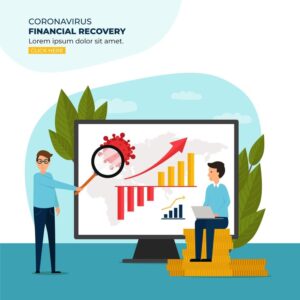Performance Management Process is one of the most experienced processes by employees of an organization. Unlike all other HR processes, that touch an employee once or twice in a year, PMS process is an on-going and regular cycle.
Following are the key steps & timelines of this process:
- Goal Setting (April – May): As the financial year kicks off, employees collaborate with their managers to establish clear and measurable goals aligned with the company’s strategic priorities. These goals serve as the bedrock for the upcoming performance management cycle. Goals are set at organization, functional and employee level. The two most popular methods of Goal Setting are Balanced Scorecard and OKR Framework.
- Mid-Year Check-In (October – November): Around the midway point of the financial year, managers and employees conduct a performance review to assess progress towards established goals. This check-in provides an opportunity for feedback and adjustments, ensuring that employees stay on course and receive the necessary support. Typically, most organizations avoid using this time to do salary increments and/or promotions.
- Self-Assessment (February-March): Employees engage in a reflective self-assessment, evaluating their performance against set goals. This process encourages employees to recognize their strengths, acknowledge areas for improvement, and articulate their contributions to the organization.
- Performance Discussions (March-April): Managers and employees engage in formal performance discussions. These conversations provide a comprehensive review of accomplishments, challenges, and development opportunities. Clear communication during this stage is crucial for mutual understanding and alignment.
- Development Planning (April-May): Following performance discussions, employees and managers collaborate on personalized development plans. This phase focuses on identifying training, mentorship, or skill-building opportunities to enhance employee growth and align individual development with organizational needs.
- Normalization Discussions (April-May): The normalization step is a crucial addition to the performance management journey. This involves comparing and adjusting performance ratings to ensure consistency across teams and departments. It prevents biases and ensures fair evaluation by accounting for variations in managerial styles and team dynamics.
- Communication & Feedback (May-June): Employees are communicated about the closure of the process, their ratings and salary increments. Additionally, feedback from employees is sought through surveys and open forums, allowing them to contribute their insights to the improvement of the performance management process.
- Final Documentation and Reporting (May-June): The performance management cycle concludes with the documentation of performance ratings, achievements, and development plans. This information is often used for salary reviews, promotions, and strategic workforce planning for the upcoming financial year.
A well-structured annual performance management process, aligned with the financial year cycle, ensures that organizations effectively manage and leverage their human capital. By adhering to the outlined timelines, businesses can foster a culture of continuous improvement, align individual efforts with organizational objectives, and propel themselves towards success in the coming financial year.
Creating an HR Strategy for a Startup Organization

When Coca-Cola embarked on its global expansion, it instituted fundamental principles. Each regional office was mandated to adopt locally relevant policies, yet certain key aspects were centralized. For instance, compensation structures were tailored to local norms and regulations, but consistently aimed to match or exceed the highest paying organizations in each respective area.
Expansion was a business call. Standardizing HR practices was that of HR department.
For every business objective, there needs to be an HR plan that should be created.
Here’s how we create a winning HR Strategy:
- Understand the Business Objectives: Meet with key stakeholders to grasp the startup’s mission, vision, and short-term/long-term goals.
- Conduct a Discovery Exercise: Assess the current workforce, their skills, strengths and motivators. Evaluate existing HR processes and systems.
- Conduct a Gap Analysis Report: Against each of these, assess which ones are going to enable the business achieve its objectives and for which certain gaps exist.
- People: Assess them on their-
- Knowledge
- Skills
- Attitude
- Process: How strong and effective the processes are. Important to also know if they are documented and the organization is unified in its understanding of the process steps.
- People: Assess them on their-
- Create an action plan: Equip the leadership team to appreciate and commit to an action plan. Help them understand the linkage between the gaps and the desired objectives. Take their concurrence on the proposed action steps.
- Get Rolling: Execute the plan like a pro. Give your best. Quality wise, timeline wise. Keep your stakeholders informed of the progress and the results.
- Review Regularly: If you are on a long term contract with them, review the progress made on the action plan on a regular basis with the leadership team.
Navigating the Skill-Will Conundrum: A Strategic Approach in Team Dynamics
In the dynamic landscape of team dynamics, managers often grapple with the challenge of individuals who fall into various categories on the Skill-Will Matrix. From those who struggle with skills to those who resist motivation, each category demands a separate approach.
Understanding the Skill-Will Matrix:

The Skill-Will Matrix serves as a valuable tool in managerial effectiveness training, providing a framework to categorize individuals based on their skill levels and willingness (will) to perform. The matrix delineates four quadrants:
- High Skill High Will
- High Skill Low Will
- Low Skill High Will
- Low Skill Low Will
While skill-related issues are relatively straightforward to address, challenges arise when individuals exhibit high skills but low will – a scenario that demands a delicate and thoughtful approach.
HR partners play a pivotal role in managing these individuals. Recognizing the potential risk of losing such team members to regrettable attrition, HR professionals need to proactively engage and support these individuals.
Individuals with high skills and low will may be hesitant to share their concerns and challenges with their reporting managers. As HR partners, creating a trusting and safe space for open communication becomes paramount. This involves establishing a long-term and regular communication plan to understand their perspective and address their issues.
To effectively manage high skill low will individuals, HR professionals must step into the roles of coaches and advocates. By working closely with these team members, HR can bridge the gaps in motivation and engagement. Celebrating and recognizing progress is crucial in motivating individuals to transition from low will to high will.
Developing a comprehensive communication plan is essential to ensuring a sustained transformation in individuals with high skills but low will. Regular check-ins, feedback sessions, and personalized development plans can contribute to their professional growth and job satisfaction.
The declining popularity of Job Rotations: A Historical Exploration of Organizational Trends

The concept of Job Rotations was once heralded as a transformative practice, fostering skill development, breaking professional stagnation, and nurturing employee growth. However, a perceptible shift has occurred in recent times, with organizations seemingly veering away from this once well-structured and encouraged intervention.
Job Rotations, as a practice, found its roots in the mid-20th century when organizations recognized the need for employees to diversify their skills and gain exposure to different functions within the company. The concept was formalized as a strategic approach to combat stagnation and employee dissatisfaction, offering a structured mechanism for career growth.
During the heyday of Job Rotations, organizations invested significantly in planning and implementing this intervention. Employees were encouraged to undertake rotations that would broaden their horizons, enhance their skill sets, and provide a holistic understanding of various business functions. This strategic approach aimed not only to benefit individual careers but also to fortify the organization by nurturing a versatile and skilled workforce.
But now, not many organizations use it as a strategic talent management intervention. The decline in the popularity of Job Rotations can be attributed to several factors that have reshaped the organizational landscape:
- Reduced Employee Tenure: The average tenure of employees has witnessed a decline, making it challenging for organizations to invest in long-term developmental initiatives like Job Rotations.
- Performance Extraction Over Career Building: A shift in organizational priorities towards immediate performance extraction rather than long-term career building has altered the focus of HR practices.
- Ease of Skill Building in Current Roles: Advancements in training partnerships and online courses have made skill-building within current roles more accessible, reducing the perceived necessity of Job Rotations.
- Lean HR Teams and Short-Term Focus: Lean HR teams, burdened with additional responsibilities such as regular reviews and reporting, often prioritize short-term gains over long-term interventions like Job Rotations.
- Changing Definition of Talent: The evolving definition of talent has led functional managers to favour buying talent over investing in prolonged developmental programs.
- Employee Risk Aversion: Employees, cognizant of organizational flux and changing priorities, may be hesitant to undertake career risks that yield results only after a few years.
Crafting Tailored Excellence: A Theoretical Approach to Implementing Performance Management in an Established Organization

The journey of implementing a Performance Management System (PMS) is a critical juncture for organizations, demanding a specific approach that goes beyond mere industry best practices. I recently worked with an organization where the founders wanted to introduce performance management process. It is an 18-year-old organization, with more than 500 employees, appx 300 of which are blue-collared.
My gut & experience gave me the confidence of knowing exactly what needs to be done. But I refrain from drawing any conclusions. I open a blank page of my diary and ask the following questions to the founders:
- What is the current Performance Management process in the organization?
- How are goals/targets/expectations currently communicated to individuals?
- What challenges are observed with the current process?
- What does Performance mean to you?
- What is the accepted meaning of the term performance within the organization?
- What behaviors do you wish to drive in your teams with a PMS process?
- How would these behaviors contribute to the organization’s goals?
- How would the Performance Management System align with the company’s strategic objectives?
- What challenges do you foresee with the implementation of a PMS framework?
- What reward mechanism do you wish to link with performance achievement?
- Are there any specific technologies or tools you envision integrating into the performance management process?
- How tech-savvy is your workforce, and how open are they to adopting new technologies?
- Any specific inputs you want me to consider in the PMS framework?
By approaching the founders with these targeted questions, I got inputs and data points that made my approach to PMS implementation extremely specific to this organization.
Implementing a Performance Management System is not a one-size-fits-all endeavor. A theoretical underpinning, rooted in thoughtful inquiry and a deep understanding of organizational intricacies, is essential. By embracing this approach, HR professionals can navigate the complexities of introducing a PMS, ensuring it is not only scientifically robust but also finely tuned to the distinctive dynamics of the organization.















